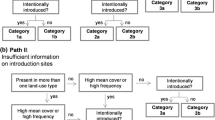Abstract
Geographic distributions of all 125 endangered and threatened animals and all 70 endangered flowering plant species were compiled and mapped by administrative territory (republics, states, provinces, and districts) of the Russian Federation, based on distributional data in the official Red Data Books of the R.S.F.S.R. [Eliseev et al. (eds) (1985) Red Book of the R.S.F.S.R.: Animals. Rosleskhoz Publishing, Moscow; Golovanov et al. (eds). (1988). Red Book of the R.S.F.S.R.: Plants. Rosagprom Publishing, Moscow]. Territories were ranked using an algorithm that gives highest rank to the single territory with the greatest number of endangered species present, then iteratively assigns the next highest rank to the territory containing the greatest number of species not found in a territory of higher rank. This algorithm minimizes the number of territories necessary to include one population of each endangered species, but may designate very low rank to a territory that holds high numbers of endangered species if many of those species are found in a territory of higher rank. When different sets of species were used to determine territory rank with this algorithm the only significant correlation between rank lists was between ranks generated when all species are used and when only species endemic to single territories were used. Mountainous territories on Russia's southern borders held the greatest numbers of endangered species and were highly ranked whether or not species occurring outside of Russia were excluded from the ranking algorithm. The Maritime state, Krasnodar state, Dagestan republic, Sakhalin province and the Jewish province all are centers of endangered species diversity that together contain 50 or more of endangered species for multiple taxonomic groups; this was the Dobson et al. [(1997) Science 275: 550–553] definition of an endangered species ‘hot spot.’ These are all mountainous territories on Russia's southern border. Precise territorial ranking within the mountainous southern regions of the Southern Far East, Caucasus, and Altai/Sayan regions of southern Siberia was highly influenced by species endemic to single territories.
Similar content being viewed by others
References
Bibby CJ (1994) Recent past and future extinctions in birds. Philosophical Transactions of the Royal Society of London B 344: 35–40
Curnutt J, Lockwood J, Hang-Kwang L, Nott P and Russell G (1994) Hotspots and species diversity. Science 367:326–327
Csuti B, Polasky S, Williams PH, Pressey RL, Camm JD, Kershaw M, Kiester AR, Downs B, Hamilton R, HusoMand Sahr K (1997) A comparison of reserve selection algorithms using data on terrestrial vertebrates in Oregon. Biological Conservation 80: 83–97
Dobson AP, Rodriguez JP, Roberts WM and Wilcove DS (1997) Geographic distribution of endangered species in the United States. Science 275: 550–553
Dunn CP, Bowles ML, Rabb GB and Jarantoski KS (1997) Science 276: 513–515
Ehrenfield D, Noss RF and Meffe GK (1997) Science 276: 515–516
Eliseev NV, Zabrodin VA, Fertikov VI, Kolosov AM and Skarlato OA (eds) (1985) Red Book of the R.S.F.S.R.: Animals. Rosleskhoz Publishing, Moscow (in Russian)
Gilpin ME and Diamond JM (1976) Calculation of immigration and extinction curves from the species-area-distance relation. Proceedings of the National Academy of Sciences of the United States of America 73: 4130–4134
Golovanov VD, Fertikov VI, Takhtadjian AL, Sokolov VE, Skarlato OA, Zabrodin VA, Kolosov AM, Popova TN and Geltman DV (eds) (1988) Red Book of the R.S.F.S.R.: Plants. Rosagprom Publishing, Moscow (in Russian)
International Council for Bird Preservation (1992) Putting biodiversity on the map: priority areas for conservation. ICBP, Cambridge
Lydolph PE (1988) Geography of the USSR. Wiley Press, New York
MacArthur RH and Wilson EO (1967) The Theory of Island Biogeography. Princeton University Press, Princeton, New York
Martin P (1994) Lake Baikal. Ergebnisse der Limnologie 4: 3–11
Olson DM and Dinerstein E (1998) The global 200: a representation approach to conserving the Earth's most biologically valuable ecoregions. Conservation Biology 12: 502–515
Pimm SL, Russel GJ, Gittleman JL and Brooks TM (1995) The future of biodiversity. Science 269: 347–350
Prendergast JR, Quinn RM, Lawton JH, Eversham BC and Gibbons DW (1993) Rare species, the coincidence of diversity hotspots, and conservation strategies. Nature 365: 335–337
Pressey RL and Nicholls AO (1989) Efficiency in conservation evaluation: scoring vs. iterative approaches. Biological Conservation 50: 199–218
Pressey RL, Posssingham HP and Day JR (1997) Effectiveness of alternative heuristic algorithms for identifying indicative minimum requirements for conservation reserves. Biological Conservation 80: 207–219
Pressey RL, Humphries CJ, Margules CR, Vane-Wright RI and Williams PH (1993) Beyond opportunism: key principles for systematic reserve selection. Trends Ecology Evolution 8: 124–128
Pulliam HR and Babbitt B (1997) Science and the protection of endangered species. Science 275: 499–500
Vane-Wright RI, Humphries CJ and Williams PH (1991) What to protect? — Systematics and the agony of choice. Biological Conservation 55: 235–254
Yeltsin B (1995) Russian Federation Federal Law on Specially Protected Nature Territories. Kremlin, Moscow (in Russian)
Author information
Authors and Affiliations
Rights and permissions
About this article
Cite this article
Griffin, P.C. Endangered species diversity ‘hot spots’ in Russia and centers of endemism. Biodiversity and Conservation 8, 497–511 (1999). https://doi.org/10.1023/A:1008837023242
Issue Date:
DOI: https://doi.org/10.1023/A:1008837023242




